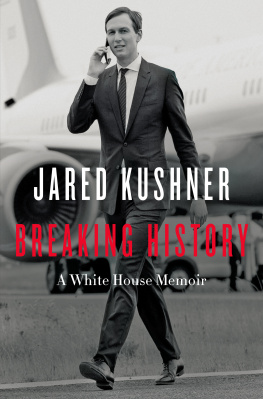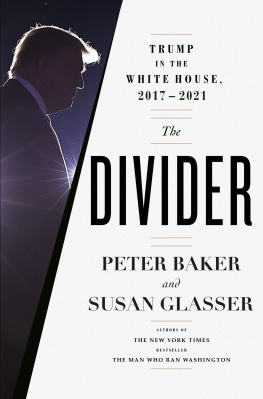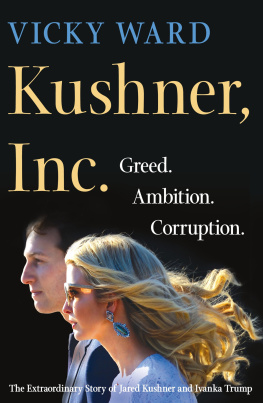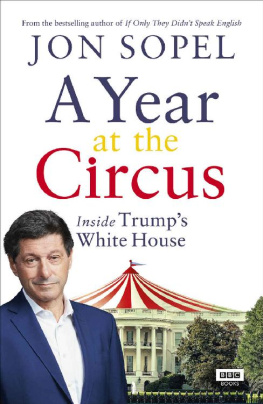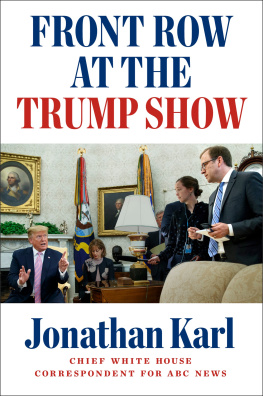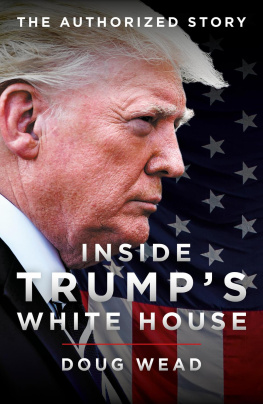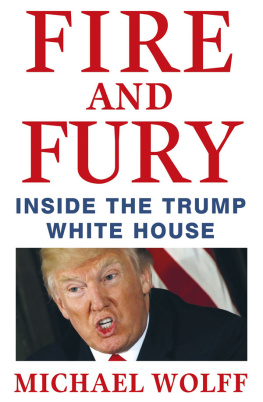To Arabella, Joseph, and Theodore
may you always chase your dreams and use your God-given potential to improve the lives of others.
If you can fill the unforgiving minute
With sixty seconds worth of distance run,
Yours is the Earth and everything thats in it,
Andwhich is moreyoull be a Man, my son!
Rudyard Kipling
Contents
I never planned to write a book, but then again I never planned to work in the White House.
As my time in government was coming to an end, several friends encouraged me to record my memories while they were still fresh. After years of nonstop action, I paused long enough to see the panorama of all I had experienced inside one of the most consequential presidencies. While I thought this chapter of my life was closing, I realized that my service would not be complete until I captured this history.
The story that follows is not your typical White House memoir, because mine was not a typical Washington experience. My untraditional role as senior adviser to a unique president made for a journey that would be hard for a writer to script if it wasnt true.
When Donald J. Trump announced his candidacy, I had no intention of getting involved in his campaign. Before long, however, I met men and women across the country who felt like Trump was finally giving them a voice, and they inspired me to play a bigger role than I had ever expected. After the 2016 election, Ivanka and I left behind our lives in New York and moved to Washington with our three young children. We knew we would face challenges, but we had no idea of the intensity of the storm that awaited us. It was probably better that we didnt.
Nothing could have prepared us for the ferociousness of Washingtonthe attacks, the investigations, the false and salacious media reports, and perhaps worst of all, the backstabbing within the West Wing itself. On several occasions I wondered if Ivanka and I had made the wrong decision about working in government. Yet we had been given this unexpected chance to serve, and it was up to us to make it count.
Each day was a race against our limited time in office. In an environment of maximum pressure, I learned to ignore the noise and distractions and instead to push for results that would improve lives. Across four years, I helped renegotiate the largest trade deal in history, pass bipartisan criminal justice reform, and launch Operation Warp Speed to deliver a safe and effective COVID-19 vaccine in record time. Humbled by the complexity of the task, I orchestrated some of the most significant breakthroughs in diplomacy in the last fifty years. In what has become known as the Abraham Accords, five Muslim-majority countriesthe United Arab Emirates, Bahrain, Kosovo, Morocco, and Sudansigned peace agreements with Israel. And Saudi Arabia and other members of the Gulf Cooperation Council resolved a bitter diplomatic and economic rift with Qatar, paving the way for additional peace deals in the future.
The Abraham Accords were a true turning point in history. If nurtured, they have the potential to bring about the complete end of the Arab-Israeli conflict that has existed ever since the founding of the State of Israel, seventy-five years ago. Already, hundreds of thousands of Arabs can make pilgrimages to the holy sites in Jerusalem. Israeli and Arab innovators, scientists, and business leaders are forging partnerships to create jobs, build infrastructure, and improve the lives of people throughout the Middle East and around the world.
As we advanced our strategy in the Middle East, we couldnt publicly discuss our approach or the positive signs we were seeing from Arab leaders. Our negotiations progressed on a knifes edge. A single untimely leak could have prompted traditionalists in the region to oppose Arab leaders who were bravely breaking with the past to make peace with Israel. Experts initially dismissed our goals as impossible, and critics delighted in my every stumble. Yet I pursued what I believed was the most logical pathway forward. Since I left government, people have often asked me how we reached these breakthroughs. I have done my best in this book to chronicle the surprising events that made them possible.
Throughout the Trump presidency, the media relied on leaks by officials who often had personal agendas. Until I saw high-stakes politics from the inside, I didnt realize how much goes on that the press fails to capture. The gap between the medias portrayal of events and the reality is far wider than I ever imagined. I eventually came to see that staff in the White House can spend their time trying to shape public perception, or they can spend it getting things done. Every administration wrestles with this challenge. It is the ticking clock in the background of every story in this book.
Many authorsincluding former senior administration officialshave tried to explain Trump through a conventional lens. Most of these accounts fail to convey how Trump thinks, why he acts the way he does, and what really happened in the Oval Office. The truth was often hiding in plain sight. Through his untraditional style, Trump delivered results that were previously unimaginable: five major trade deals, tax cuts for working families, massive deregulation, the lowest unemployment in fifty years, criminal justice reform, a COVID-19 vaccine in less than a year, confronting China, defeating ISIS, no new wars, and peace deals in the Middle East. In this book, I dont try to speak for Trump, but I do share a lot of previously undisclosed personal interactions that will hopefully give readers a deeper understanding of Trumps personality and management style.
During my four years in the White House, I learned countless lessons that changed my perspective about how the governmentand the worldreally works. Three stand out.
The first is that its easy to make promises, but its hard to achieve results. Trump came into office without an army of experienced bureaucrats and Washington insiders. Finding people who both believed in his agenda and knew how to operate the levers of power proved to be an ongoing challenge. At every turn, people within the government tried to prevent the president from keeping his promises to move the American embassy to Jerusalem, withdraw from the Iran deal, build the wall on the nations southern border, and renegotiate NAFTA, among many bold actions. I met hundreds of smart, competent, and patriotic people who worked tirelessly behind the scenes to get things done. Yet it takes only one bureaucratic barrier, congressional complication, or powerful individual to stop progress. Washington is programmed to resist change, even though change is what voters say they want most.
I remember one meeting that typified the resistance Trump faced in Washington from both Republicans and Democrats. A veteran of the George W. Bush administration came to see me to discuss US-China trade policy. While he fully agreed with our aims on China, he thought that using tariffs was a grave mistake. When I asked him what he would recommend instead, he suggested more rounds of talks. I said the first thing that came to mind: So you want us to accomplish something you couldnt by doing it the same way you did it? For the Washington establishment, the answer to that question was a resounding yes. Many Beltway insiders are experts at pointing out problems, but theyre even better at shutting down solutions. When confronted with the potential risks of change, they play it safe for fear that any disruption to the current system will jeopardize their political careers. This explains why even some of Trumps own cabinet members clashed with him and those of us who believed that it was time to take calibrated risks and deliver more opportunities for the American people. Instead of spending endless energy diagnosing the problem, I focused on clearly defining the optimal solution and then worked backwards to reach the best possible outcome.

